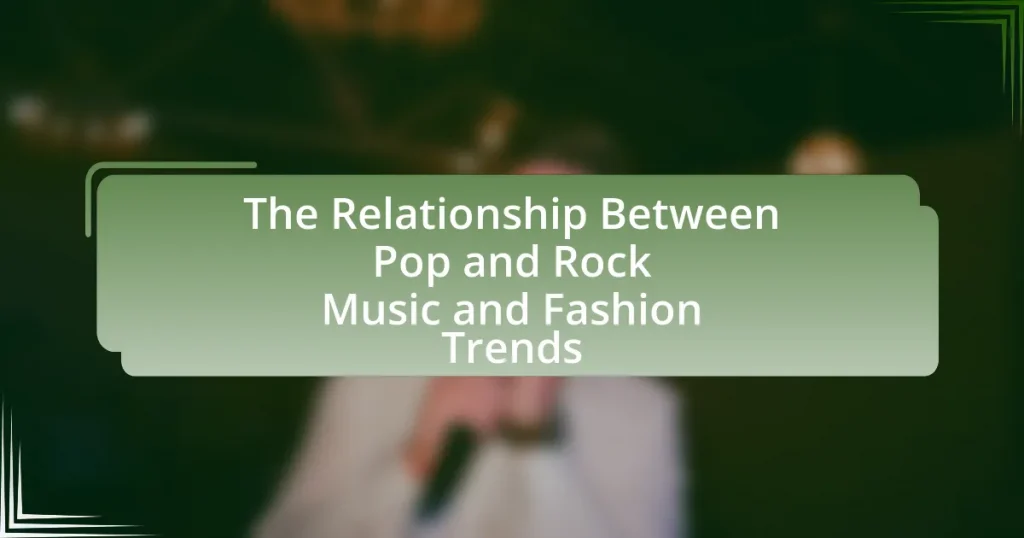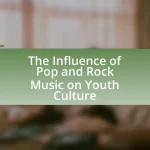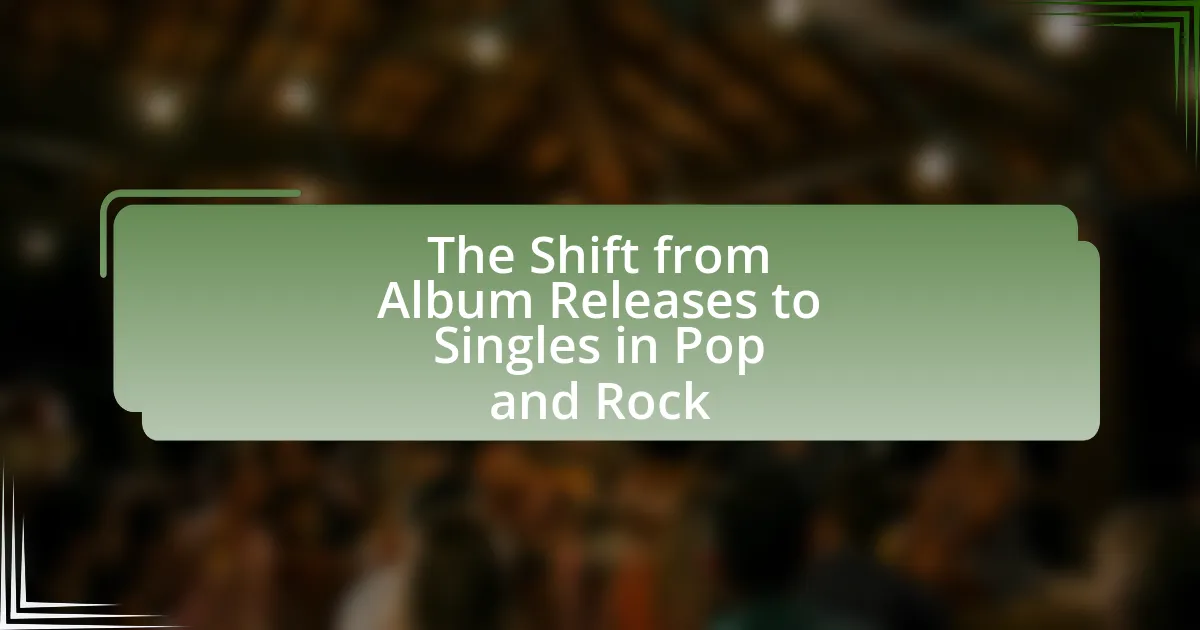The article examines the intricate relationship between pop and rock music and fashion trends, highlighting how musical movements have historically influenced clothing styles and cultural expressions. It details the evolution of fashion from the 1950s to contemporary times, showcasing key styles associated with various music genres, including rock and roll, punk, glam rock, and pop. The discussion emphasizes the role of fashion in shaping artist identities, conveying messages, and enhancing the storytelling aspect of music videos. Additionally, it explores current trends influenced by social media and the blending of high fashion with streetwear, illustrating how contemporary artists continue to leverage fashion to enhance their musical careers.
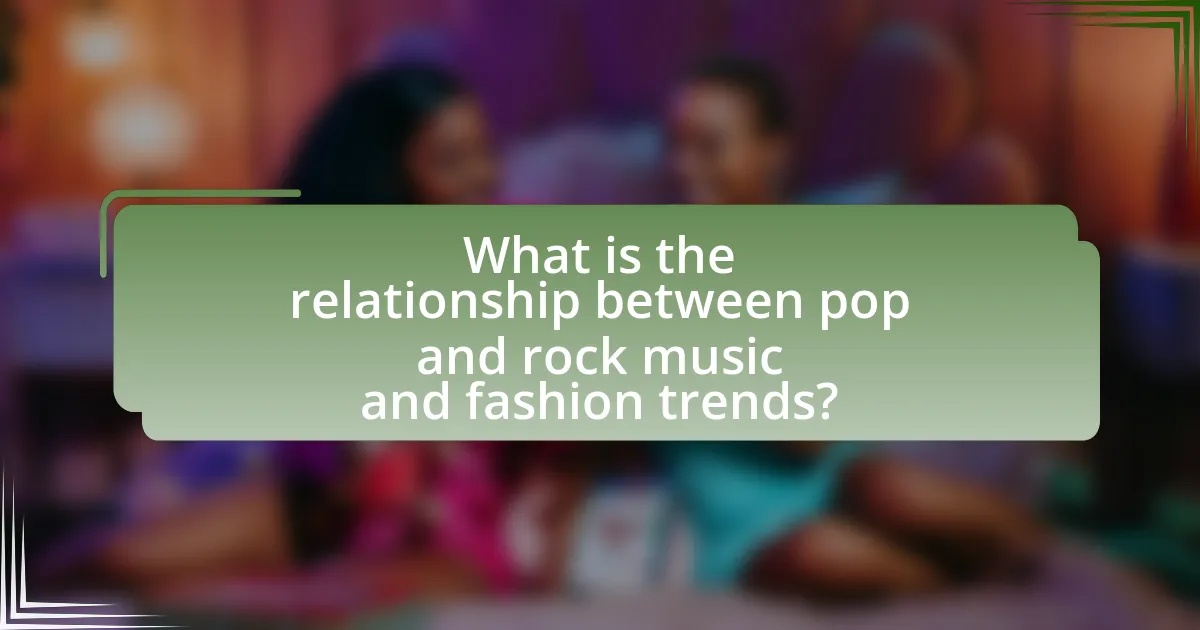
What is the relationship between pop and rock music and fashion trends?
Pop and rock music significantly influence fashion trends, as artists often set styles that fans emulate. For instance, the 1960s saw The Beatles popularizing tailored suits and mop-top hairstyles, which became iconic fashion statements. Similarly, the punk rock movement of the 1970s, led by bands like The Ramones and Sex Pistols, introduced ripped clothing, leather jackets, and bold hairstyles, shaping a rebellious fashion aesthetic. These trends demonstrate how music genres not only reflect cultural attitudes but also drive fashion choices, creating a symbiotic relationship where each influences the other.
How have pop and rock music influenced fashion trends over the decades?
Pop and rock music have significantly influenced fashion trends over the decades by shaping styles that reflect the cultural and social movements of their times. For instance, in the 1950s, rock and roll icons like Elvis Presley popularized leather jackets and pompadour hairstyles, which became symbols of youth rebellion. In the 1960s, artists such as The Beatles and Jimi Hendrix introduced colorful, psychedelic clothing that mirrored the counterculture movement, leading to the widespread adoption of bell-bottoms and tie-dye patterns.
The 1970s saw punk rock bands like The Ramones and Sex Pistols promote a DIY aesthetic characterized by ripped jeans, band t-shirts, and spiked accessories, which challenged mainstream fashion norms. In the 1980s, pop stars like Madonna and Michael Jackson influenced trends with bold, extravagant styles, including lace gloves and shoulder pads, reflecting the era’s emphasis on individuality and excess.
The 1990s brought grunge music, led by bands like Nirvana, which popularized flannel shirts and combat boots, emphasizing a more casual, anti-fashion approach. In the 2000s and beyond, artists like Lady Gaga and Beyoncé have continued to push fashion boundaries, blending high fashion with streetwear, thus influencing contemporary trends.
Overall, the interplay between pop and rock music and fashion has created a dynamic relationship where musical movements often dictate style choices, reflecting broader societal changes and youth culture.
What specific fashion styles emerged from the pop music scene?
Specific fashion styles that emerged from the pop music scene include glam rock, punk, and streetwear. Glam rock, popularized in the early 1970s by artists like David Bowie and T. Rex, featured flamboyant clothing, platform shoes, and bold makeup. Punk fashion, which gained prominence in the late 1970s through bands like the Sex Pistols and The Clash, was characterized by leather jackets, ripped jeans, and DIY aesthetics. Streetwear, influenced by hip-hop culture in the 1980s and 1990s, incorporated casual styles such as oversized t-shirts, sneakers, and baseball caps, with brands like Supreme and Off-White becoming iconic. These styles reflect the cultural impact of pop music on fashion trends throughout the decades.
How did rock music shape the fashion choices of its era?
Rock music significantly influenced the fashion choices of its era by promoting styles that reflected the rebellious and countercultural attitudes of its artists. Iconic figures like Elvis Presley and later bands such as The Beatles and The Rolling Stones popularized leather jackets, tight jeans, and bold hairstyles, which became synonymous with youth culture in the 1950s and 1960s. The emergence of punk rock in the 1970s further transformed fashion, introducing elements like ripped clothing, safety pins, and DIY aesthetics, as seen in the styles of bands like The Sex Pistols. This evolution in fashion was not just a reflection of musical trends but also a response to social and political movements, making rock music a catalyst for broader cultural shifts in clothing and personal expression.
Why is fashion an important aspect of pop and rock music culture?
Fashion is an important aspect of pop and rock music culture because it serves as a visual representation of the music’s identity and values. The styles adopted by artists often reflect the themes of their music, influencing fans and shaping cultural trends. For instance, the punk movement in the 1970s utilized fashion as a form of rebellion, with artists like the Sex Pistols and their distinctive leather jackets and ripped clothing symbolizing anti-establishment sentiments. Additionally, fashion icons such as David Bowie and Madonna have used their unique styles to challenge societal norms and express individuality, further intertwining fashion with musical expression. This relationship is evident in the way fashion trends often emerge from music scenes, creating a cyclical influence where music inspires fashion and vice versa.
How does fashion contribute to the identity of pop and rock artists?
Fashion significantly contributes to the identity of pop and rock artists by serving as a visual representation of their musical persona and cultural message. The clothing choices of these artists often reflect their genre, personal style, and the themes of their music, creating a distinct image that resonates with their audience. For instance, artists like David Bowie and Madonna utilized fashion to challenge societal norms and express individuality, which became integral to their identities and public personas. Additionally, fashion trends in pop and rock music often influence broader cultural movements, as seen in the punk rock movement of the 1970s, where fashion became a form of rebellion against mainstream culture. This interplay between fashion and music solidifies the artist’s identity and enhances their connection with fans, making it a crucial element of their overall artistic expression.
What role does visual presentation play in the success of pop and rock music?
Visual presentation is crucial for the success of pop and rock music as it enhances the artist’s brand identity and engages audiences on multiple sensory levels. Artists like David Bowie and Lady Gaga have utilized striking visual elements, such as costumes and stage design, to create memorable performances that resonate with fans and elevate their music’s impact. Research indicates that visually appealing performances can increase audience retention and emotional connection, leading to higher sales and streaming numbers. For instance, a study published in the Journal of Popular Music Studies highlights that artists who invest in visual aesthetics often see a significant boost in their overall popularity and marketability.
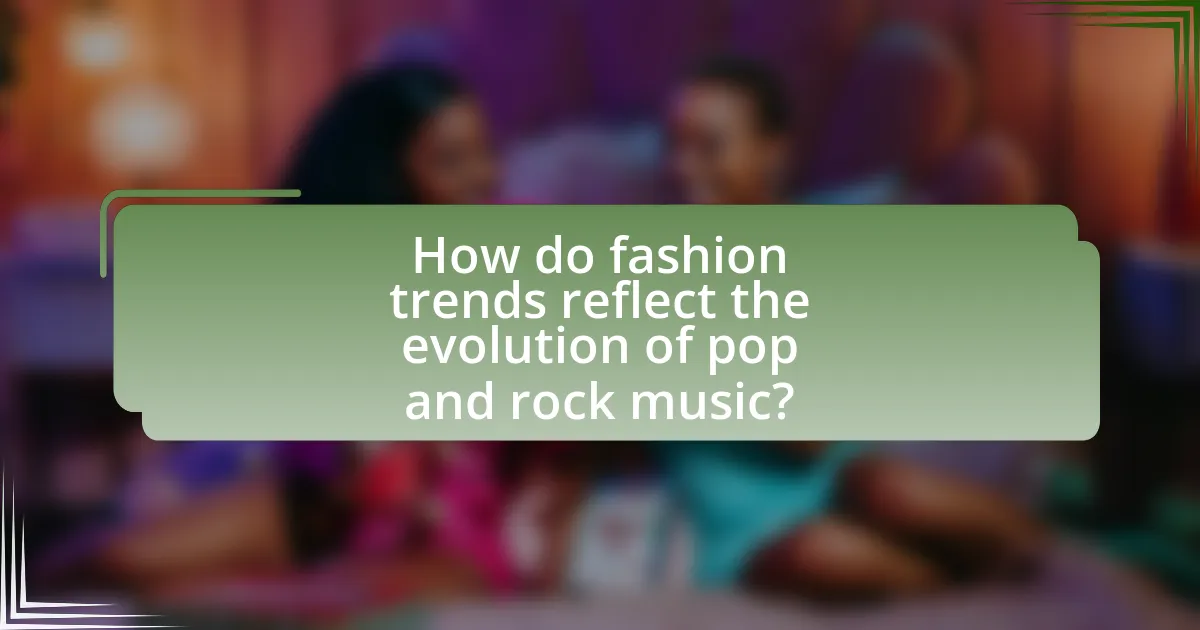
How do fashion trends reflect the evolution of pop and rock music?
Fashion trends reflect the evolution of pop and rock music by visually embodying the cultural and social changes that these music genres represent. For instance, the rebellious styles of the 1950s rock and roll era, characterized by leather jackets and denim, mirrored the youth’s desire for independence and defiance against societal norms. In the 1960s, the psychedelic fashion associated with bands like The Beatles and The Doors showcased the counterculture movement, emphasizing vibrant colors and eclectic patterns that paralleled the experimental nature of their music.
As pop music evolved in the 1980s, fashion trends shifted towards bold, extravagant styles, influenced by artists like Madonna and Michael Jackson, who used fashion as a means of self-expression and identity. This period saw the rise of designer labels and the commercialization of music, where fashion became an integral part of an artist’s brand.
In contemporary times, fashion trends continue to reflect the evolution of pop and rock music through the embrace of diversity and inclusivity, as seen in the styles of artists like Billie Eilish and Lil Nas X, who challenge traditional gender norms and promote individuality. This ongoing relationship illustrates how fashion not only complements music but also serves as a powerful medium for cultural commentary and social change.
What are the key fashion movements associated with different music genres?
Key fashion movements associated with different music genres include punk, grunge, hip-hop, and pop. Punk fashion, emerging in the 1970s, is characterized by leather jackets, ripped jeans, and DIY aesthetics, reflecting rebellion against mainstream culture. Grunge fashion, popularized in the early 1990s by bands like Nirvana, features flannel shirts, baggy jeans, and combat boots, symbolizing a laid-back, anti-fashion attitude. Hip-hop fashion, originating in the 1980s, includes oversized clothing, sneakers, and accessories like gold chains, representing urban culture and self-expression. Pop music fashion, often driven by artists like Madonna and Britney Spears, emphasizes glamorous, trend-setting styles, including bold colors and high-fashion elements, influencing mainstream fashion trends. Each genre’s fashion reflects its cultural context and the values of its community, demonstrating the interconnectedness of music and style.
How did the punk movement influence fashion in rock music?
The punk movement significantly influenced fashion in rock music by introducing a rebellious aesthetic characterized by DIY elements, bold graphics, and unconventional styles. This movement, emerging in the mid-1970s, rejected mainstream fashion norms, favoring leather jackets, ripped jeans, band t-shirts, and distinctive hairstyles like brightly colored mohawks. The punk ethos emphasized individuality and anti-establishment sentiments, which were visually represented through fashion choices. Iconic punk bands such as the Sex Pistols and The Ramones not only shaped musical trends but also set new standards for visual identity in rock, leading to a lasting impact on subsequent genres and artists.
What fashion trends are synonymous with the rise of pop music in the 1980s?
The fashion trends synonymous with the rise of pop music in the 1980s include bold colors, oversized clothing, and distinct accessories such as leg warmers and fingerless gloves. These trends were heavily influenced by pop icons like Madonna and Michael Jackson, who popularized styles characterized by vibrant patterns, high-waisted jeans, and statement jewelry. The emergence of music videos as a dominant medium during this decade further amplified these fashion choices, as artists showcased their unique styles, leading to widespread adoption among fans. For instance, Madonna’s “Like a Virgin” performance introduced lace gloves and layered necklaces, which became iconic elements of 1980s fashion.
How do artists use fashion to convey messages in their music?
Artists use fashion to convey messages in their music by utilizing clothing and style choices that reflect their identity, beliefs, and the themes of their work. For instance, musicians often adopt specific fashion trends to align with cultural movements or social issues, such as punk rock artists who embraced a rebellious aesthetic to challenge societal norms in the 1970s. This visual representation enhances the lyrical content and emotional resonance of their music, making the message more impactful. Historical examples include Madonna’s use of provocative fashion to address themes of sexuality and empowerment in the 1980s, which not only defined her brand but also influenced societal perceptions of gender roles. Thus, fashion serves as a powerful tool for artists to communicate their artistic vision and connect with their audience on a deeper level.
What are some examples of artists who have used fashion as a form of expression?
Artists such as David Bowie, Madonna, and Lady Gaga have prominently used fashion as a form of expression. David Bowie, known for his alter ego Ziggy Stardust, utilized flamboyant costumes to challenge gender norms and create a unique persona that resonated with his music. Madonna’s ever-evolving style, from the lace and crucifixes of the 1980s to the more avant-garde looks in her later career, has consistently reflected her artistic reinventions and social commentary. Lady Gaga has made headlines with her bold fashion choices, such as the meat dress at the 2010 MTV Video Music Awards, which served as a provocative statement on individuality and societal norms. These artists exemplify how fashion can be intertwined with musical identity and cultural commentary.
How does fashion help in the storytelling aspect of music videos?
Fashion enhances the storytelling aspect of music videos by visually representing the themes, emotions, and narratives conveyed in the music. Through the use of specific clothing styles, colors, and accessories, artists can create a visual identity that aligns with the song’s message, thereby deepening the audience’s emotional connection. For instance, in the music video for “Bad Romance” by Lady Gaga, the avant-garde fashion choices reflect themes of love and conflict, reinforcing the song’s dramatic narrative. This synergy between fashion and storytelling not only captivates viewers but also establishes a cultural context that resonates with the audience, making the overall experience more impactful.
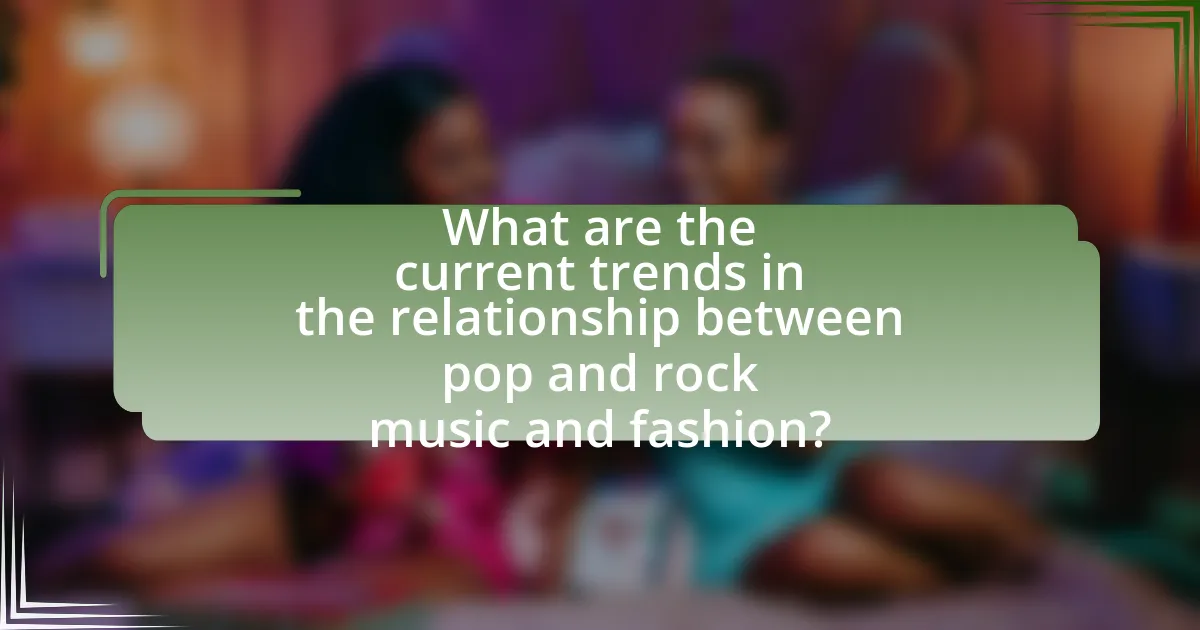
What are the current trends in the relationship between pop and rock music and fashion?
Current trends indicate a significant fusion between pop and rock music and fashion, characterized by a revival of 90s and early 2000s aesthetics. This trend is evident in the resurgence of oversized silhouettes, graphic tees, and vintage denim, which are popular among artists like Billie Eilish and Harry Styles. Additionally, the blending of genres has led to a more eclectic fashion sense, where artists often mix high fashion with streetwear, as seen in collaborations between musicians and luxury brands. The influence of social media platforms, particularly TikTok and Instagram, has accelerated these trends, allowing for rapid dissemination and adoption of styles that reflect both musical and fashion identities.
How are contemporary artists blending fashion with their musical styles?
Contemporary artists are blending fashion with their musical styles by using clothing and visual aesthetics as integral components of their artistic expression. For instance, artists like Billie Eilish and Lil Nas X have made bold fashion choices that reflect their identities and musical themes, often collaborating with high-fashion designers to create unique looks that resonate with their audiences. This fusion is evident in Eilish’s oversized silhouettes that challenge traditional gender norms and Lil Nas X’s vibrant, theatrical outfits that enhance his genre-blending sound. The impact of this trend is significant, as it not only influences popular culture but also drives fashion sales, with the global fashion industry increasingly recognizing the importance of music in shaping trends.
What are the latest fashion trends emerging from the pop and rock scenes?
The latest fashion trends emerging from the pop and rock scenes include oversized silhouettes, vibrant colors, and a mix of vintage and modern styles. Artists like Billie Eilish and Harry Styles are influencing these trends by embracing gender-fluid fashion, often incorporating bold patterns and eclectic accessories. For instance, Eilish’s signature baggy clothing contrasts with Styles’ tailored suits and statement pieces, showcasing a blend of comfort and high fashion. This evolution reflects a broader cultural shift towards self-expression and individuality in fashion, as seen in the increasing popularity of thrift shopping and sustainable brands among fans.
How do social media and digital platforms influence fashion in music today?
Social media and digital platforms significantly influence fashion in music today by enabling artists to showcase their styles directly to fans, creating trends that can spread rapidly. Platforms like Instagram and TikTok allow musicians to share their fashion choices in real-time, leading to immediate fan engagement and imitation. For instance, artists such as Billie Eilish and Lil Nas X have utilized these platforms to establish unique fashion identities that resonate with their audiences, resulting in viral trends. According to a 2021 study by the Fashion Institute of Technology, 70% of consumers reported that social media influences their fashion choices, highlighting the direct correlation between digital presence and fashion trends in the music industry.
What can we learn from the historical relationship between music and fashion?
The historical relationship between music and fashion reveals that they significantly influence each other, shaping cultural identities and trends. For instance, the punk movement in the 1970s, characterized by its rebellious music, also introduced a distinctive fashion style featuring leather jackets, ripped jeans, and bold hairstyles, which became symbols of defiance against mainstream culture. Additionally, artists like Madonna in the 1980s not only transformed pop music but also set fashion trends with her eclectic style, influencing youth culture globally. This interplay demonstrates how music genres often dictate fashion trends, while fashion serves as a visual representation of the music’s cultural impact.
How can upcoming artists leverage fashion to enhance their musical careers?
Upcoming artists can leverage fashion to enhance their musical careers by using their personal style as a form of branding that resonates with their music and audience. Fashion serves as a visual representation of an artist’s identity, allowing them to create a memorable image that can attract attention and differentiate them in a crowded market. For instance, artists like Billie Eilish and Lil Nas X have successfully utilized unique fashion choices to establish strong personal brands, leading to increased visibility and engagement with their fan base. This strategic use of fashion can result in collaborations with fashion brands, increased media coverage, and opportunities for merchandise sales, all of which contribute to an artist’s overall career growth.
What best practices should artists follow to align their fashion with their music style?
Artists should ensure their fashion choices reflect their music style by developing a cohesive brand identity that resonates with their artistic message. This involves selecting clothing, accessories, and overall aesthetics that align with the themes and emotions conveyed in their music. For instance, rock artists often adopt edgy, rebellious styles, while pop artists may opt for vibrant, trendy outfits that appeal to mainstream audiences.
Additionally, artists should consider their target audience and cultural influences when curating their fashion. Research indicates that visual representation significantly impacts audience perception and engagement, as seen in the success of artists like David Bowie, who used fashion to enhance his musical persona. By consistently aligning their fashion with their music, artists can create a memorable and authentic image that strengthens their connection with fans.
